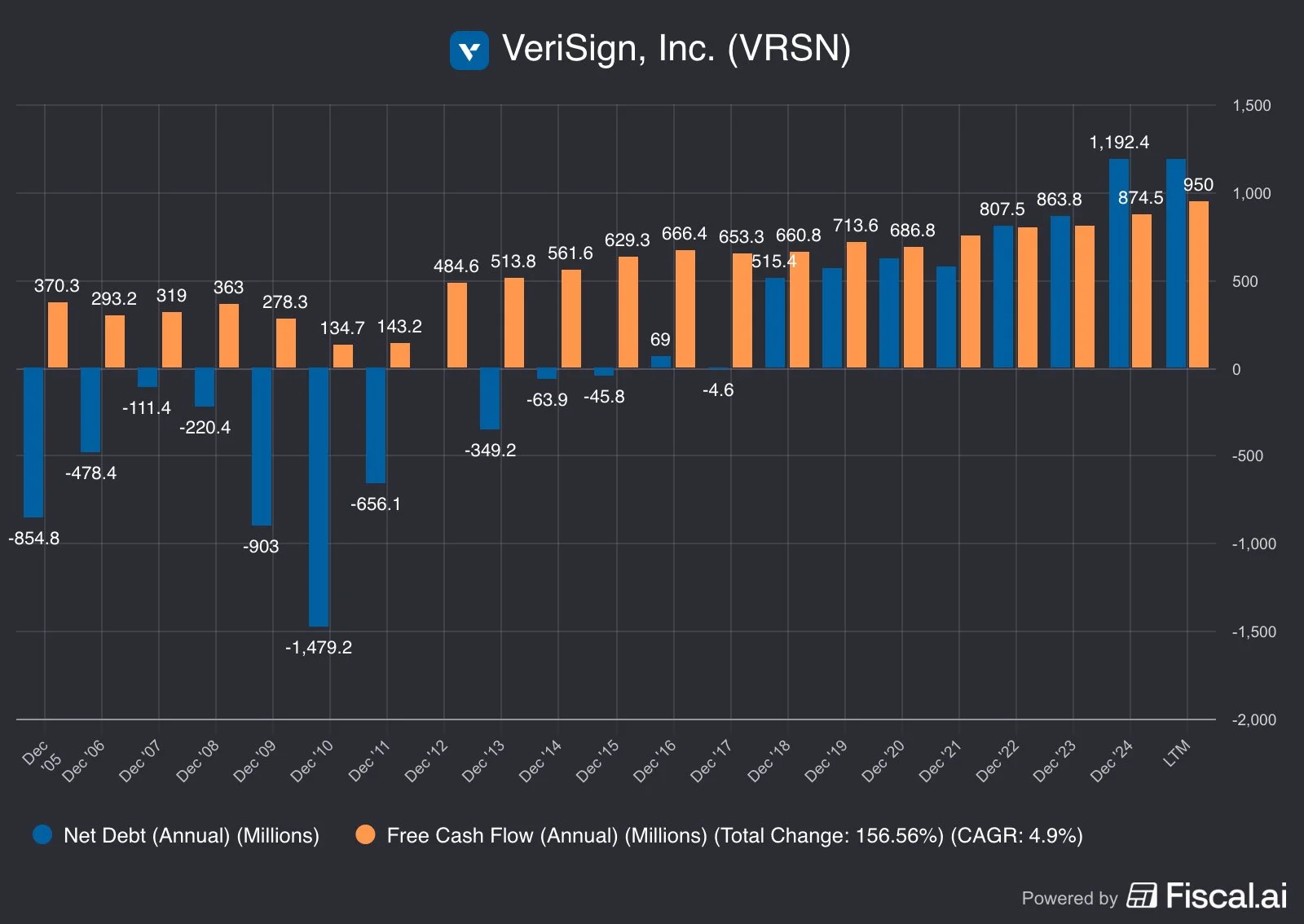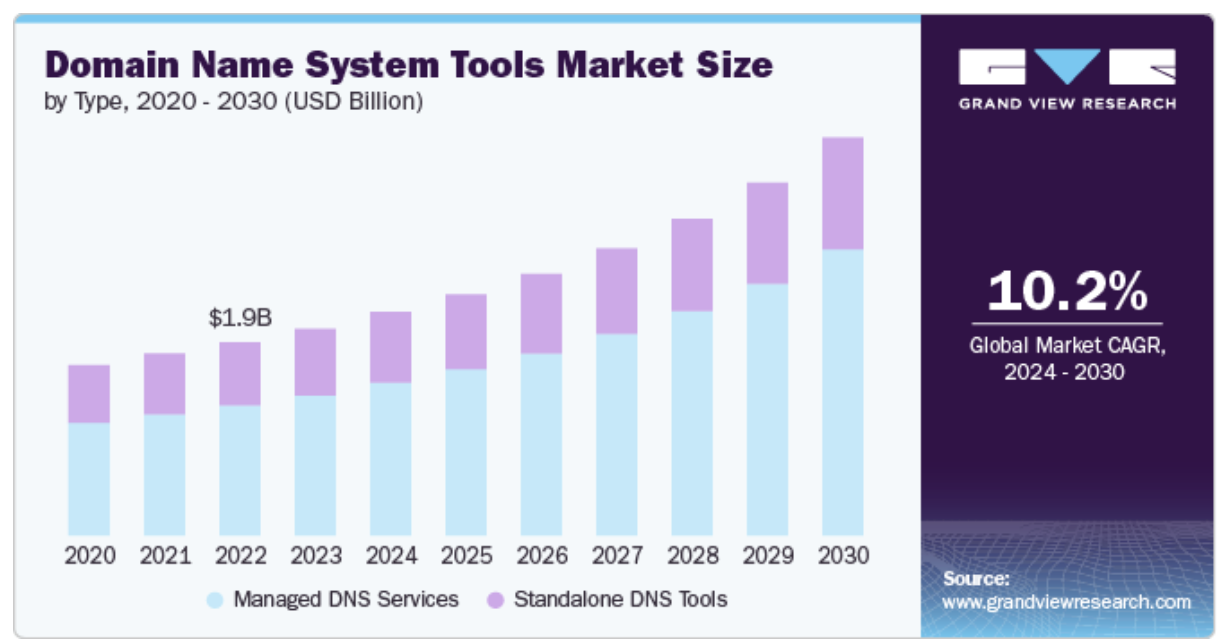Should You Invest in VeriSign?
Quick Company Snapshot
Founded: 1995 (spun out from RSA Data Security)
Market Cap: ~$25B
CEO: D. James Bidzos (Founder, RSA co-founder)
Headquarters: Reston, VA
Ticker: VRSN (NASDAQ)
Core Business: Registry operator for .com and .net domains
Every time you type a “.com” or “.net,” you’re using VeriSign’s infrastructure — whether you know it or not.
This is the plumbing of the internet: invisible, indispensable, and built to never fail.
VeriSign (NASDAQ: VRSN) runs the backbone of online identity, managing the .com and .net registries with 100% uptime for nearly 30 years.
In a market obsessed with “what’s next,” VeriSign wins by being what always works.
In a volatile tech market, VRSN’s recurring revenues and high margins offer shelter as the market is currently at a historic high.
Key Investment Thesis: VeriSign (VRSN)
Founder Influence & Leadership Alignment: Veteran founder-CEO Jim Bidzos still steers VeriSign with disciplined execution, backed by Berkshire Hathaway’s 1.5% vote of confidence and pay tightly tied to long-term performance.
Durable Competitive Advantage: VeriSign operates a structural monopoly over .com and .net—an irreplaceable, government-backed internet utility with 27 years of flawless uptime and immense pricing power.
Very Profitability Business Model: With ROIC near 48% 5 years average and ~68% operating margins, VeriSign converts nearly every revenue dollar into profit—one of the world’s most efficient cash machines.
Capital Allocation: Minimal reinvestment needs fuel aggressive buybacks and a new dividend, compounding shareholder value without weakening the balance sheet.
Valuation (Quality at a Price): Trading near 32× earnings, the stock bakes in perfection—investors pay for monopoly quality, not growth, leaving little margin for error.
Market Opportunity: The DNS market is expanding, but VeriSign’s growth remains measured (~7% EPS pace); stability, not acceleration, is the real attraction.
How VeriSign Makes Money
1. Domain Registry Services (Core)
Operates .com and .net under long-term ICANN contracts.
Charges ~$10 per year per domain.
Renewal rate ~75%.
Predictable, subscription-like revenue stream.
2. Digital Identity Services (Legacy)
SSL/TLS certificates and authentication tools.
Now a small slice but part of its “trust infrastructure.”
By Geography: Global revenue base; domains are worldwide — no heavy regional exposure.
Management & Culture
CEO: Jim Bidzos — founding visionary still leading.
Insider Ownership: ~0.5% valued $121 million, but Berkshire’s 1.5% stake offsets concerns.
Pay Alignment: 93% of CEO compensation is tied to TSR vs. S&P 500 and operating income CAGR.
Culture: Tight, technical, and ownership-driven. Bidzos has guided VRSN through decades of change with calm precision.
They have a great team — it’s a disciplined operator of mission-critical infrastructure.
Capital Allocation
CapEx: Just ~3% of OCF — ultra-light.
Buybacks: $301M in Q2; $1.28B still authorized.
New Dividend: $0.77/share quarterly.
ROIC: 48% 5Yr Avg among the highest in tech.
The formula: spend little, buy back stock, return cash. Classic compounding.
Profitability: Off the Charts
Gross Margin: ~88%
Operating Margin: ~68%
Net Margin: ~50%
FCF Conversion: >100% of net incom
VeriSign doesn’t just make money — it barely spends it.
Moat: Structural Monopoly
Contracts: Sole operator for .com and .net under ICANN.
Switching Costs: Businesses can’t risk losing domains; renewal rates near 76%.
Barriers to Entry: Decades of trust, government oversight, and technical complexity.
Brand Power: “.com” is the global standard of legitimacy online.
This isn’t a competitive market. It’s a controlled utility for the digital age.
Valuation & Margin of Safety
P/E: 32×
P/FCF: 27×
Forward P/E: 30×
Expected Growth: ~7% EPS CAGR (4% revenue + 3% buybacks).
DCF: Requires 12% growth to justify today’s price.
In short: premium valuation, thin margin of safety.
The upside is stability, not explosive returns
Balance Sheet Strength
Debt: ~$1193M (easily covered by cash flow).
Free Cash flow: $950M
Interest Coverage: 14×
Built for resilience, not leverage.
Growth Outlook
DNS Market CAGR: 10–18% through 2030.
VeriSign Growth: ~7% annual EPS via pricing and buybacks.
Expansion Capacity: Plenty of FCF and $1.5B buyback firepower.
Realistically: slow, steady, and predictable.
Performance vs. Peers (5-Year Total Return)
Verisign has underperformed the market by all metrics including its peers.
VRSN: +25% (CAGR 4.6%)
GoDaddy (GDDY): +75% (CAGR 12%)
Cloudflare (NET): +285% (CAGR 31%)
S&P 500: +108% (CAGR 16%)
A safe compounder that lagged the market’s flashier names.
Risks to Watch
Domain Saturation: .com growth flattening.
Regulatory Overhang: ICANN and U.S. Commerce control pricing.
Concentration: 90%+ revenue from two domains.
Competition: Cloudflare and others innovating faster.
Tech Shifts: Social and AI reducing reliance on domains.
Geopolitics: China exposure and data compliance.
Even monopolies aren’t bulletproof.
Conclusion:
VeriSign is a monopoly that has compounded 8% in the last 24 years.
Margins near 70%, ROIC in the mid-40s, fortress balance sheet, and flawless operational history.
But at 32× earnings, investors are buying quality, not growth.
My conviction level is high for defensive portfolios.
But my thesis: Own for stability and cash flow. Avoid chasing it for growth.
The Upside is a modest growth, low risk — a solid asymmetry for conservative capital.
Think of it like investing in a low-risk bond.
SCC Rating: 67% | Neutral
At silvercrosscapital we built the Outlier Portfolio on one truth: a handful of stocks create nearly all long-term wealth.
Our mission? Find the next outlier before Wall St. does.
The question: Is this an outlier? Not even close.









